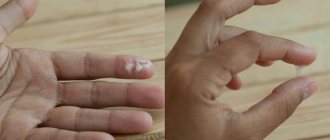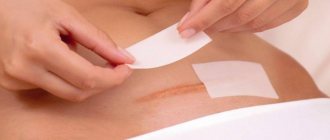For new parents, hygiene of the child’s genital organs often becomes a certain difficulty when caring for a baby. However, the granite of the science of child hygiene becomes pliable after mastering the theory and several practical sessions. With proper treatment of skin folds, many “non-childish” problems in children can be avoided.
Basic questions of child hygiene How often do hygiene procedures need to be carried out? The baby should be washed every time after a bowel movement, as well as before bedtime (during evening swimming, the water temperature is 36.0 - 37.0 C) in order to remove residual urine and feces. After urination, the child’s genitals can be wiped with a damp cloth, but some children with sensitive perineal skin (redness and itching occur from minimal irritation) require washing more often.
What is the best way to wash? It is advisable to carry out the procedure with ordinary warm running water (in this case, an adult must thoroughly wash their hands in advance). You can use baby soap or special baby bathing products.
Adult products are not suitable; they dry out the baby’s delicate skin and disrupt its normal microbial flora. For hygienic care of the genitals, you should also not use potassium permanganate and herbs, so as not to cause dry skin and allergies.
Which is correct? The child should be placed on the arm of an adult, tummy down, bring the buttocks under the stream of water, with your free hand, move from front to back, from the pubis to the anus, wash the genitals (labia, penis, scrotum) and folds of skin. And only so! This is especially true for girls’ hygiene, otherwise intestinal microbes can enter the vagina and urinary tract.
Some experts advise boys to wash the penis without moving the foreskin, others recommend carefully exposing the head of the penis as much as the extensibility of the foreskin allows. Therefore, it is better to select a suitable treatment option for a boy’s genitals, taking into account his physiological characteristics.
Wash the head with water or treat it with baby oil, then return the foreskin to its place. If it does not allow you to open the head, there is no need to do this forcibly, otherwise pinching of the head in the foreskin may develop - paraphimosis, which will require urgent surgical correction.
What's next? – After washing, you need to cover the child with a towel and carefully blot the moisture in the perineum. – Any children’s cosmetics must be tested on an adult’s skin before use on a baby. To do this, you need to rub a small amount of the product on the skin of the elbow and observe the reaction. After 5-10 minutes, no redness or rash should appear in the area. In addition, pediatricians advise applying baby cream, talc, oil, etc. first to the mother’s palms and only then to the baby’s skin. If the baby's skin is healthy (velvety, pink), there is no point in using baby cosmetics excessively, since the skin must “breathe”, and hygiene products can disrupt this process. – Skin folds are lubricated with baby cream (for application under disposable diapers). It is better to wait until it is absorbed and then remove the excess. During this time, the child will receive a so-called air bath, which is very important for the prevention of diaper rash (the baby’s skin must be dry before using a new diaper). – You should change disposable diapers at least 8 times a day, after waking up, before feeding, after bowel movements (and washing), before going for a walk, before going to bed at night. It is recommended to wear each of them for no more than 3 hours. Proper use of modern, high-quality diapers that retain moisture well does not harm the child’s health.
Consequences of poor hygiene Diaper dermatitis (diaper rash) is a pathological condition of a child’s skin, provoked by exposure to physical, chemical and microbial factors when using diapers or disposable diapers. There is a rash, redness, itching in the perineal area, peeling of the skin of the buttocks.
If irritating factors are not eliminated, pustules, erosions and secondary infections may occur. In mild cases, skink, salicyl, and panthenol creams will help; frequent changes of “breathable” diapers and air baths are also recommended.
Synechia (from the Greek synecheia - “continuity”, “connection”, “adhesions”) - congenital or acquired fusions between neighboring organs. They occur in both girls (the labia minora are fused) and boys (the foreskin and glans penis are fused). This can lead to difficulty urinating and infection.
In girls, the occurrence of synechiae is associated with low levels of estrogens (female sex hormones), as well as with the presence of inflammation of the vulva. The labia come into contact, and as the mucous membrane heals, conditions are created for their fusion. Special wound-healing creams recommended by the doctor will help, which are applied in a thin layer after washing the synechiae. At night, a cream containing estrogen is applied in the same layer.
In boys (if there is no inflammation), it is recommended to separate synechiae after 5 years and later, since there is a possibility of their “self-destruction.” In general, for synechiae that do not cause any discomfort to the baby, you are better off choosing a wait-and-see approach. The more often they are separated, the greater the likelihood of their recurrence, and this can have a negative psychological impact on the child.
We monitor the hygiene of the child’s genital organs. It is necessary to undress the child every day on the changing table and examine the genitals, skin of the perineum, inguinal and intergluteal folds. If alarming signs or doubts appear, you should contact a pediatrician, pediatric gynecologist or urologist.
– painful urination (before, during and after urination, the child winces, grunts, cries), acute urinary retention; – change in the color of urine (usually it is pale yellow, in older age the urine is straw-yellow); – redness, itching of the inguinal and intergluteal folds, skin and mucous membranes of the genital organs; – unpleasant odor, discharge from the genital tract; – suspicion of abnormal structure of the child’s organs, the presence of tumor-like formations or protrusions in the groin areas, scrotum (hernia).
Hormonal crisis of newborns
During development inside the womb, the child, together with the mother, goes through all stages of hormonal changes and receives sex hormones in considerable concentration.
Before birth, the level of these substances is especially high, and after birth in infants it gradually returns to normal. This process is called a sexual or hormonal crisis. Its manifestations can be seen in both boys and girls in the form of acne, swelling of the mammary glands, and in some cases the release of a substance similar to colostrum is noticeable from them.
Often in infants in the first month there is swelling of the genital organs, accompanied by a certain secretion. This is also a consequence of the release of the sex hormones estrogen. It can be bloody, liquid white, yellow or green, and mucous in nature. In most cases this is the norm, but there are exceptions.
Signs of a hormonal crisis can appear from 1–2 days to several months, and its peak occurs 6–7 days after birth. Basically, complete cleansing of excess hormones is completed in the fifth week.
Bloody vaginal discharge in infants
According to statistics, discharge in infants occurs in 9% of cases. This phenomenon is called neonatal metrorrhagia. The child’s genital organs: the surface of the uterus, its cervix and the vaginal mucosa are in a similar condition to the organs of a woman of reproductive age before menstruation.
The hormone estrogen received from the mother stops acting, as a result of which the mucous layer of the uterus is rejected. Blood discharge in an infant girl can be pink, scarlet, brown, or beige. The secretion appears a few days after birth and disappears after 2-3 days.
There is no reason to worry in this situation. The main thing is to maintain the hygiene of the newborn and ensure that such processes do not drag on for a long time.
Mucous and white discharge in newborn girls
The presence of white discharge in infant girls is associated with the following reasons:
- Remains of original lubricant. Indicated in the form of a mucous coating, reminiscent of sticky leucorrhoea, in the vagina and on the folds of the labia. Pediatricians do not recommend washing them out with special means, but recommend waiting until the substance disappears naturally. With its help, the baby's sensitive skin adapts to the new external environment.
- Mucus can also be produced by the glands of the vagina. The reason for these discharges is the same as for bloody ones - hormones, only in this case the hormones responsible for milk production work: prolactin and progesterone. This kind of secretion in infants usually disappears by the end of the first month.
- A similar symptom may occur due to the reaction of the newborn’s body to hormonal changes that can provoke the development of vulvovaginitis. Discharge is indicated in small quantities, and they are white, yellow, green, and sometimes transparent. Vaginitis is often accompanied by redness and swelling of the baby’s external genitalia. The symptoms go away after a few days and do not cause discomfort to the baby.
Pathological discharge in girls under one year old
The appearance of vaginal discharge in girls under one year of age in 90% of cases is a characteristic of the norm, since this period is characterized by regular hormonal fluctuations. But sometimes this sign indicates pathology.
You should be wary if:
- secretion does not disappear two months after birth;
- the duration of discharge is more than 2–3 days;
- mucus has an unpleasant odor and purulent nature;
- the baby cries when urinating, because it is accompanied by discomfort;
- there is excessive discharge, bleeding;
- there is an inflammatory process in the genital organs;
- an atypical color of urine and blood admixtures were noticed;
- A violation of the anatomical development of the genital organs was diagnosed.
These phenomena can occur due to physiological problems in the child, but most often they occur due to improper care of the genitals.
Hygiene of a newborn girl
A girl’s discharge may appear at 1, 2, 3, or 4 months. All this is the result of changes in hormonal levels, which are especially active in the first year of life. The main rule during this period is to maintain hygiene for the infant, which is especially important in the first month of life.
- When washing your child, use only boiled water at 36 °C. Some experts advise using chamomile decoction, but remember, it can dry out the mucous membranes and also cause an allergic reaction. Therefore, it is better to choose special cosmetics intended for newborns for these purposes. Sometimes they can be alternated with a weak decoction of the series.
- When washing, the perineum is washed first, and only then the anus, i.e. the direction of movement is from front to back. Otherwise, feces or opportunistic bacteria from the anus can enter the genitals and provoke the development of an infectious or inflammatory process. In the first month, wash your baby as often as possible.
- Do not try to remove the white residue mentioned above. This lubricant will go away on its own.
- Be sure to cut the nails on your hands so as not to damage the child’s mucous membrane during water procedures.
- From time to time, spread the baby's labia to prevent them from merging.
- When using creams or diaper powders, make sure that the products do not get into the perineum.
- Periodically give your baby air baths. The skin should rest from diapers and diapers.
- Monitor odors and discharge patterns, if any.
How to deal with discharge
If discharge is detected in a newborn girl, the following recommendations must be followed:
- carefully observe the rules of sexual hygiene;
- do not use when regularly washing the grass (this leads to dry skin and mucous membranes of the child);
- follow the correct washing technique - first of all, the genitals are washed, and then the anus;
- regularly spread the labia (this will avoid their fusion);
- allow the skin and genitals to breathe more often, freeing them from diapers;
- do not remove white plaque between the labia.
- use only boiled water for washing (in the absence of allergic reactions, a weak chamomile decoction can be used).
Feedback from women and expert opinion
Maria, 26 years old: “On the 7th day after the birth of her daughter, she discovered bloody-pinkish discharge. I was very scared, although the child did not cry and behaved calmly. It was Saturday and while we waited until Monday to see a doctor, the blood disappeared. What should we do?"
Maria Stepanovna, pediatrician: “In newborns, in the first weeks of life, a sexual crisis occurs, associated with the liberation of the baby’s body from maternal hormones accumulated during the intrauterine period. In girls, it manifests itself as bloody vaginal discharge. They come in pink, brown and ichor-shaped. The phenomenon disappears after 2–3 days, but sometimes appears until the second month. This is a natural process, there is no reason to worry.”
Angelina, 35 years old: “My daughter is 4 days old. Even when I started looking at her on the first day, I saw a white coating on the labia. I tried to remove it with wet wipes but nothing worked. Maybe it's thrush?
Maria Stepanovna, pediatrician: “In the first days of life, remnants of vernix lubrication can be observed on the body of a newborn. They are especially noticeable on the baby's head and in the folds on the body. In girls, they accumulate in the labia and perineum. There is no need to delete them. The plaque will go away on its own in a few days, but if its presence has increased and the baby begins to act up, only then is there reason to suspect some kind of disorder and consult a doctor. In 95%, we are talking about a natural physiological process.”
Briefly about the main thing
Not only women of reproductive age, but also infants, especially in the first weeks of life, experience secretion from the vagina. Bloody, pink, white discharge in newborn girls is a natural consequence of a hormonal crisis. It is typical for all babies, as the body is cleansed of excess maternal hormones. It occurs differently for everyone, in some cases manifesting itself as bloody discharge in infant girls. It is important to maintain your child's hygiene and not worry.
In the first days after birth, parents may notice discharge in newborn girls. Of course, this is often scary, since many mothers believe that this is not a normal phenomenon. This is wrong. Let's find out what is normal and when you should contact a specialist.
Puberty
After 11 years, girls begin puberty. During this period, which is also called puberty, spotting may occur. They indicate the onset of menarche - the first menstruation, which indicates the beginning of puberty in a girl. Discharge is not considered dangerous and requires treatment, because this period is important for every girl. During the restructuring of the body, the production of eggs begins. If fertilization does not occur, the mature egg leaves the body along with the upper layer of the endometrium. This rejection is a monthly process in a girl’s body – menstruation.
Sometimes spotting in girls aged 11 to 18 years can be pathological. This occurs when juvenile uterine bleeding occurs. They are dysfunctional in nature. During this period, disruption of the menstrual cycle may occur, as well as disruption of the functioning of the ovaries. These bleedings are considered a complex pathology, which is gaining momentum from year to year, increasingly appearing in girls. Sometimes it is difficult to diagnose, since the bleeding may coincide in timing with the onset of the next menstruation. However, there is an important symptom that characterizes this particular type of pathology - large blood loss.
Often juvenile spotting appears during the year between the onset of the next menstruation. They can begin within two to three years after menarche. The symptoms of dangerous bleeding are as follows: profuse bleeding; irregular menstruation; soreness.
It is not difficult to identify the symptoms of juvenile bleeding in a girl: blood spots are found in the smear between menstruation. They may occur for the first time after a missed period. In this case, the bleeding lasts for more than a week.
If any of these manifestations occur, you should consult a gynecologist to clarify the diagnosis. Most often they are caused by dysfunction of the organs of the reproductive system. Women's health should be under special control, starting from a very early age. Indeed, in the future this can affect the reproductive function of the body, causing its disturbances.
A small child requires maximum attention from adults. After all, he has found himself in a world completely alien to him and it will take a lot of time before he adapts to it. And now the baby is very vulnerable and requires special care with daily hygiene. The baby's nose is cleaned, its eyes are washed, and it is washed. Pediatric doctors advise examining the child daily, paying special attention to the groin and skin folds. This is especially true for girls.
Newborn girls experience vaginal discharge. And this, according to doctors, is not something to be afraid of. This is not a pathology, this is the norm for a newborn. Experts call this phenomenon a sexual crisis.
The sexual crisis frightens parents because the discharge in newborn girls is bloody, which in the eyes of parents, especially young ones, is an undoubted pathology. And they start to panic.
As pediatricians say, discharge in newborn girls is quite normal. Thus, the child’s body starts the cleansing process, adapting to life in an environment that is new to it. The thing is that before childbirth, the mother’s body accumulates estrogens - these hormones are necessary to activate the birth process. Accordingly, the child’s body receives them, and in excess. But while the child is in the intrauterine state, this is the norm for him.
But after childbirth, communication with the mother ceases. Accordingly, the supply of these hormones to the child’s body stops. But they are still unnatural for him, so he begins to cleanse himself of them. It begins on the third or fourth day of life and lasts an average of 2 weeks. But sometimes the process takes up to 6-8 weeks.
Bloody discharge in a newborn girl
Bloody discharge in a newborn can be of two types:
- bloody grayish-white;
- bloody yellowish.
Discharge of this kind appears in 5-8% of newborns in the first week of life and lasts 1-2 days. In this case, the same condition of the cervix, uterus and vaginal mucous membranes is observed as in the period before menstruation.
The cause of spotting that appears in newborn girls is the sudden cessation of the action of the maternal hormone estrogen in the baby’s body, which she received during pregnancy.
Does not require treatment and goes away on its own. The mother needs to wash the baby with warm boiled water to prevent accidental infection.
The most important thing is the baby’s health
Types of discharge
In newborn girls, vaginal discharge is normal in most cases and does not pose any danger or harm to health. They can have different viscosity, color and composition. The following types are distinguished:
- Bloody issues. They are observed mainly on days 3–7 after birth and are a consequence of a sexual or hormonal crisis. This is explained by the fact that before giving birth, a woman experiences an increase in the level of female sex hormones (prostaglandin and estrogen), which subsequently enter the fetus’s body. At this stage, the reproductive system of the mother and baby reacts equally to the surge in hormones, so the latter also experiences growth of the mucous membrane of the uterine walls (endometrium). After the child is born, there is a sharp decrease in the amount of estrogen due to the loss of communication with the mother’s body (the child’s ovaries are not yet able to produce it). This leads to the rejection of the upper layer of the endometrium, and, consequently, the appearance of liquid blood spots. During this period, no treatment is required and it is enough to carefully monitor the hygiene of the genital organs to prevent infection. The bleeding stops after a few days.
- White discharge. Accumulate between the labia minora and labia majora. They are also formed as a result of a sexual crisis and are produced by the walls of the vagina in response to the action of the hormones prolactin and progesterone. In this case, you should not make excessive efforts to remove the secretory fluid, since there is a high risk of injury to the mucous membrane or infection. It is enough to regularly wash the child with warm boiled water.
- Yellow discharge. Observed in newborns (regardless of gender) in the first days of life after birth. In medicine, this phenomenon is called uric acid infarction, and does not pose any danger to the child’s health. They are formed due to the content of urate salt in the urine. In rare cases, the secretory fluid turns a bright orange color and goes away on its own after breastfeeding begins.
It should be remembered that regardless of whether a newborn girl has discharge or not, careful hygiene of the genitals is necessary. It is recommended to wash the child after each diaper change (you can use boiled water or a weak chamomile decoction).
What is a hormonal crisis?
Infants may experience leucorrhoea in the folds of the labia. They are usually whitish mucous membranes and stop by the end of the first or second month of life. This is a consequence of the action of maternal hormones, as well as their active release from the child’s body during the first weeks of life.
This phenomenon is called a hormonal crisis or sexual crisis. It is characteristic that it can manifest itself not only in girls, but also in boys. During this period, it is important for young parents to maintain hygiene of the baby’s genital organs.
Why does sticky mucous discharge appear from the vagina?
Discharge from the genital tract of a newborn girl in the first days of life can manifest itself in different ways, but usually it is white, yellow, light and transparent, bloody. Usually this phenomenon is extremely frightening for the mother and father. Adults who know nothing begin to make various assumptions, wondering why they arise. Some even think that this is menstruation, but children's age is an unnatural problem.
White (resembling leucorrhoea)
If you notice cheesy white accumulations in the folds of the labia on a girl, do not be alarmed. This is a natural reaction of the body. The vaginal walls react this way to the hormones prolactin and progesterone. Large amounts of these hormones are found in breast milk. You should not try to remove plaque or somehow specifically get rid of it. Normal hygiene measures are sufficient. Usually, by the end of the first month of life, the genital slit is cleared.
Yellowish from the genitals
Yellow discharge is a consequence of a uric acid crisis, which occurs when the body tries to get rid of excess salts. The phenomenon occurs in newborns regardless of gender.
Outwardly they are yellow, even orange. After some time they go away on their own and do not require special treatment.
Greens
Green discharge is classified as pathological and requires consultation with a doctor. They can be abundant, mixed with pus, blood, and accompanied by a strong unpleasant odor. Indicate an inflammatory process occurring in the mucous membranes of the vagina or pelvic organs.
The reason is the physiological characteristics of children's organs. The mucous membrane lining the vagina in infants has a loose structure and is extremely tender. Moreover, there is no necessary environment for the development of lactic acid fermentation, which prevents the proliferation of pathogenic bacteria. In this regard, favorable conditions for pathogenic microorganisms are created in the children's vagina.
Unhealthy discharge may appear due to decreased immunity, allergic diseases, and poor hygiene. Most often, yellowish-green discharge indicates bacterial vulvovaginitis (inflammation of the vaginal mucosa).
Competent pediatrician
The following symptoms appear:
- redness and swelling of the vagina;
- severe itching and burning, which can be suspected if the child begins to cry after urinating.
Gray color
If the microflora balance is disturbed, little girls may develop gray secretions with a creamy consistency. In principle, this is not a dangerous phenomenon if the color of the discharge does not change, it does not have an unpleasant odor and does not last more than three days. If they are grayish and liquid, this is characteristic of desquamative vulvovaginitis, which occurs in 60-70% of very young children in the first 3 days after birth.
Light and transparent
Transparent foamy discharge indicates the presence of a trichomonas infection in the baby. And light watery ones appear when the mucous membrane becomes very thin and dry, indicating allergic vulvovaginitis.
Types of discharge and accompanying symptoms
This article talks about typical ways to solve your issues, but each case is unique! If you want to find out from me how to solve your particular problem, ask your question. It's fast and free
!
In the first days, newborns most often experience white, sticky mucus. The secretion accumulates in the folds of the genital organs and can be mistaken for the remains of vernix lubrication. It should not be removed with antiseptics; it is important to wash the child more often with warm water without soap. There is no need to scrub off the plaque - it disappears on its own a few weeks after birth.
There is no need to worry if your newborn has bleeding. The appearance of pink secretion is associated with the rejection of excess endometrium. Under the influence of prostaglandin and estrogen, the walls of the girl’s uterus increase. After childbirth, the amount of hormones in the body decreases sharply, which is manifested by mucous membrane separation and slight bleeding.
The secret of a rich yellow color is not a deviation either. Such discharge indicates a uric acid infarction in a newborn and does not harm her health. The occurrence of this condition is associated with an increased concentration of uric acid, which is why the child’s urine takes on a brick color. The plaque disappears a few days after the start of breastfeeding.
During the newborn period, discharge is a variant of the norm
Hormonal imbalance in the mother's body contributes to the accumulation of glycogen in the fetus - a complex carbohydrate that provokes the proliferation of Dederlein's rods. Lactobacilli are normally included in the microflora of a girl’s vagina, but in combination with polysaccharides they form a light yellow coating, which quickly disappears if personal hygiene rules are observed.
You should be wary if a girl has abundant secretion mixed with pus. This deviation indicates an inflammatory process in the genitals.
With inflammation, gray-green discharge is accompanied by the following symptoms:
- redness and swelling of the skin in the groin area;
- burning and itching when urinating.
What kind of discharge can a baby girl have?
If you notice discharge from your newborn daughter, pay attention to the baby’s age.
In the first days of life
The first days of life are characterized by:
- bloody discharge in a newborn girl. They go away on their own within 2-3 days;
- orange, yellow, pink. A uric acid crisis is characteristic of the early period of life and disappears by the end of the first week after birth, as soon as the mother establishes breastfeeding;
- ordinary mucous membranes resembling leucorrhoea. These are remnants of the original lubricant, which will clear up on its own over time.
Clean and dry
At 1 month
At 1 month of age, a girl's leucorrhoea, resembling a white sticky coating between the folds of the labia, is considered normal. This is a condition that does not require treatment and usually goes away on its own by 6-8 weeks of life.
2 month
By the second month, the discharge in infants should go away. If the white, cheesy buildup does not go away by week 8, your baby should be taken to the doctor.
3 month
Discharge found in a 3-month-old baby may indicate ongoing inflammatory processes, and therefore require consultation with a pediatric gynecologist. It could be:
- bacterial vulvovaginitis. Accompanied by redness and not abundant yellow discharge;
- vulvovaginitis provoked by enterobiasis. Worms bring pathogenic microbes from the intestines into the vagina - enterococcus and E. coli;
- foreign body in the vagina - toilet paper, threads, etc. As a result, the walls of the vagina are damaged and inflammation develops;
- exudative diathesis. This chronic disease can provoke vulvar hyperemia and dry mucous membranes;
- candidiasis - curdled white discharge may appear against the background of herpes, trichomoniasis;
- Trichomonas. Infection is possible through household means or during childbirth. Accompanied by copious foamy discharge.
Restless babe
If the child is 3 months or older
If parents notice white discharge in a newborn girl, this is normal, but in the third month of life this may be the first sign of an inflammatory process in the baby’s body. Therefore, you should not postpone your visit to the pediatric gynecologist. Most often at this age, unpleasant symptoms appear against the background of:
- Bacterial vulvovaginitis. However, in this case, the girl’s discharge will not be white, but yellow. Redness may be noticeable in the groin area.
- Vulvovaginitis caused by enterobiasis. In this case, we are talking about worms that transferred pathogenic microorganisms from the child’s intestines to the vagina.
- Entry of a foreign body into the vagina. These could be pieces of toilet paper, threads and much more. This may well cause damage to the child's vagina and lead to serious inflammation.
- Exudative diathesis. This pathology is classified as chronic. This condition can lead to vulvar hyperemia. This causes dryness of the vaginal mucous membranes.
- Candidiasis. Such manifestations can also occur against the background of herpes. It may well provoke the appearance of white discharge in newborn girls and older babies.
- Trichomonas. A newborn baby can become infected through the birth canal, and an older girl can become infected through household means. In this case, the discharge will be more foamy.
It is also worth considering one of the most common reasons for the appearance of white mucous discharge in a newborn girl.
Is it necessary and how to clean and rinse?
Frightened mothers about the corresponding changes are wondering what to do with the child? The main rules for how to act when dealing with discharge:
- Maintain hygiene. Wash your girl daily and after each urination with warm water. You can use chamomile decoction. After washing, you need to cover the child with a towel. Let your baby's skin breathe for a few minutes. If the weather is warm, you should spend as much time as possible without clothes or a diaper.
- Keep out. Do not try to remove white plaque from the uterus, cervix and vagina on your own. Do not use soap or gel while washing. This can disrupt the very delicate mucous layer.
- Prevent splicing. Hygiene for newborn girls involves carefully spreading the labia after almost every wash. This will prevent their possible fusion.
How to care for your baby's vagina
Proper intimate hygiene for an infant is an important point for the further development of organs and women's health. Caring for the baby should take place in the following sequence:
- Wash your hands with soap to avoid infection in your baby's vagina during the procedure.
- Wash your baby every time you change her diaper (about every 3-4 hours during the day). Hygiene procedures are required after waking up in the morning and before going to bed in the evening.
- Do not wash the girl in the bath; the water should be running and the pressure should not be strong.
- You need to wash the baby towards the anus. This is necessary to prevent feces from getting into the vagina and causing inflammation.
- Carry out hygiene of the anus and vagina separately. After washing the anus, wash your hands with soap and then wash the girl. This will prevent E. coli from entering the genitals, which leads to inflammation of the genitourinary tract.
- Use only plain water or water with chamomile infusion added. Use baby soap or gel to wash after bowel movements.
- Do not use a washcloth so as not to injure the baby’s delicate mucous membranes.
- Remove any remaining powder and cream from the labia with a cotton swab and sterilized oil in the morning and evening.
If in the first weeks of your baby's life you notice white or bloody discharge from the vagina, do not be alarmed, but keep an eye on it. This is a hormonal or sexual crisis that will pass in a few days.
Comfortable position
Condition of the girl's genitals after birth
Another interesting phenomenon of the neonatal period of life is the uric acid crisis. At the same time, you may find yellow spots in the diaper, sometimes so bright that you can even call them orange. This happens regardless of the sex of the child in the first days after birth. These are just salts in the urine; they also do not require treatment and go away on their own.
Free delivery by courier in Moscow and St. Petersburg on the day of order. Sending orders to other regions by Russian Post and various transport companies. Let's try to figure out what this process does, how to properly wrap a baby in a diaper, and in general, whether it's worth doing. However, the granite of the science of child hygiene becomes pliable after mastering the theory and several practical sessions.
What's next? – After washing, you need to cover the child with a towel and carefully blot the moisture in the perineum. To do this, you need to rub a small amount of the product on the skin of the elbow and observe the reaction. The labia come into contact, and as the mucous membrane heals, conditions are created for their fusion. In boys (if there is no inflammation), it is recommended to separate synechiae after 5 years and later, since there is a possibility of their “self-destruction.”
However, at the time when they appeared, it should be remembered that she needs special intimate hygiene for a newborn girl. A newborn girl should have her own soap and towel. The intimate hygiene of a 2-year-old girl should be based on the same principles and rules as the hygiene of a newborn baby. No matter how it is! - the parents of a newborn girl can safely say when they struggle with a full diaper for the first time.
For new parents, hygiene of the child’s genital organs often becomes a certain difficulty when caring for a baby. However, the granite of the science of child hygiene becomes pliable after mastering the theory and several practical sessions. With proper treatment of skin folds, many “non-childish” problems in children can be avoided.
Basic questions of child hygiene How often do hygiene procedures need to be carried out? The baby should be washed every time after a bowel movement, as well as before bedtime (during evening swimming, the water temperature is 36.0 - 37.0 C) in order to remove residual urine and feces. After urination, the child's genitals can be wiped with a damp cloth, but some children with sensitive perineal skin (redness and itching occur from minimal irritation) require washing more often.
What is the best way to wash? It is advisable to carry out the procedure with ordinary warm running water (in this case, an adult must thoroughly wash their hands in advance). You can use baby soap or special baby bathing products.
Adult products are not suitable; they dry out the baby’s delicate skin and disrupt its normal microbial flora. For hygienic care of the genitals, you should also not use potassium permanganate and herbs, so as not to cause dry skin and allergies.
Which is correct? The child should be placed on the arm of an adult, tummy down, bring the buttocks under the stream of water, with your free hand, move from front to back, from the pubis to the anus, wash the genitals (labia, penis, scrotum) and folds of skin. And only so! This is especially true for girls’ hygiene, otherwise intestinal microbes can enter the vagina and urinary tract.
Some experts advise boys to wash the penis without moving the foreskin, others recommend carefully exposing the head of the penis as much as the extensibility of the foreskin allows. Therefore, it is better to select a suitable treatment option for a boy’s genitals, taking into account his physiological characteristics.
Wash the head with water or treat it with baby oil, then return the foreskin to its place. If it does not allow you to open the head, there is no need to do this forcibly, otherwise pinching of the head in the foreskin may develop - paraphimosis, which will require urgent surgical correction.
What's next? – After washing, you need to cover the child with a towel and carefully blot the moisture in the perineum. – Any children’s cosmetics must be tested on an adult’s skin before use on a baby. To do this, you need to rub a small amount of the product on the skin of the elbow and observe the reaction. After 5-10 minutes, no redness or rash should appear in the area. In addition, pediatricians advise applying baby cream, talc, oil, etc. first to the mother’s palms and only then to the baby’s skin. If the baby’s skin is healthy (velvety, pink), there is no point in excessively using baby cosmetics, since the skin must “breathe”, and hygiene products can disrupt this process. – Skin folds are lubricated with baby cream (for application under disposable diapers). It is better to wait until it is absorbed and then remove the excess. During this time, the child will receive a so-called air bath, which is very important for the prevention of diaper rash (before using a new diaper, the baby’s skin must be dry). – Disposable diapers should be changed at least 8 times a day, after waking up, before feeding, after bowel movements (and washing), before going for a walk, before going to bed at night. It is recommended to wear each of them for no more than 3 hours. Proper use of modern, high-quality diapers that retain moisture well does not harm the child’s health.
Consequences of poor hygiene Diaper dermatitis (diaper rash) is a pathological condition of a child’s skin, provoked by exposure to physical, chemical and microbial factors when using diapers or disposable diapers. There is a rash, redness, itching in the perineal area, peeling of the skin of the buttocks.
If irritating factors are not eliminated, pustules, erosions and secondary infections may occur. In mild cases, skink, salicyl, and panthenol creams will help; frequent changes of “breathable” diapers and air baths are also recommended.
Synechia (from the Greek synecheia - “continuity”, “connection”, “adhesions”) are congenital or acquired fusions between neighboring organs. They occur in both girls (the labia minora are fused) and boys (the foreskin and glans penis are fused). This can lead to difficulty urinating and infection.
In girls, the occurrence of synechiae is associated with low levels of estrogens (female sex hormones), as well as with the presence of inflammation of the vulva. The labia come into contact, and as the mucous membrane heals, conditions are created for their fusion. Special wound-healing creams recommended by the doctor will help, which are applied in a thin layer after washing the synechiae. At night, a cream containing estrogen is applied in the same layer.
In boys (if there is no inflammation), it is recommended to separate synechiae after 5 years and later, since there is a possibility of their “self-destruction.” In general, for synechiae that do not cause any discomfort to the baby, you are better off choosing a wait-and-see approach. The more often they are separated, the greater the likelihood of their recurrence, and this can have a negative psychological impact on the child.
We monitor the hygiene of the child’s genital organs. It is necessary to undress the child every day on the changing table and examine the genitals, skin of the perineum, inguinal and intergluteal folds. If alarming signs or doubts appear, you should contact a pediatrician, pediatric gynecologist or urologist.
Warning signs:
– painful urination (before, during and after urination, the child winces, grunts, cries), acute urinary retention; – change in the color of urine (usually it is pale yellow, in older age the urine is straw-yellow); – redness, itching of the inguinal and intergluteal folds, skin and mucous membranes of the genital organs; – unpleasant odor, discharge from the genital tract; – suspicion of abnormal structure of the child’s organs, the presence of tumor-like formations or protrusions in the groin areas, scrotum (hernia).
You need to go to a pediatric gynecologist or ask your gynecologist what to do
When a child is just born, parents undoubtedly pay him a huge amount of attention. This especially applies to the mother, because she must not only quickly establish breastfeeding, but also spend as much time as possible with her baby.
At the same time, do not forget about the child’s hygiene. The list of these procedures should include daily air baths and examination of the child’s genitals, inguinal folds, and so on. Of course, you shouldn’t worry too much if you notice something wrong, because what is unacceptable for older children is normal for newborns. It is also worth noting that if you notice vaginal discharge in a girl, then there is no need to worry, because doctors call this a sexual crisis.
When should you contact a pediatric gynecologist?
Usually, discharge in girls that lasts up to 6-8 weeks is considered normal and does not cause any discomfort. If they last longer, this is a reason to contact a specialist to rule out possible problems.
Contact your doctor if you have any of the following symptoms:
- the baby feels pain and stinging after urination, which is signaled by loud screaming and crying;
- greenish purulent discharge;
- The girl’s discharge has a strong, unpleasant odor;
- lasts more than 3 days, is released profusely in the form of red and bloody spots, as during the menstrual period. The phenomenon of nosebleeds is observed;
- the genitals appear to be inflamed (redness, swelling);
- a newborn’s urine is of an unnatural color (normally it is very light and does not change color);
- bloody urine;
- there are signs of anatomical disorders of the organs.
Feels good
Caring for a baby during discharge
You should be as careful as possible and under no circumstances try to remove the white plaque that has accumulated between the labia, since the mucous membrane of an infant is highly vulnerable to infections. It is useful to arrange frequent air baths, holding the baby less in a diaper or diaper, especially during discharge. Everything described above is considered normal and natural processes for newly born children; if discharge from the genital organs is observed in girls after the first two weeks of life, it should be urgently shown to a pediatrician or pediatric gynecologist to diagnose and exclude serious problems in the future.
You should also not delay visiting your doctor if:
- The infant cries, screams, winces during urination, experiencing pain and stinging;
- Green purulent vaginal discharge;
- the smell of vaginal discharge from a newborn is sharp and unpleasant;
- The discharge is very copious and prolonged;
- Inflammation of the child’s genital organs is observed;
- Bloody spots are observed in the urine of an infant; and other deviations that cause concern.
Main rules and prevention
Caring for newborns is not difficult if you follow all the rules of hygiene and do not forget about prevention:
- Provide airing after swimming. This will protect the baby's skin and it will not be susceptible to diaper rash.
- The water temperature should be comfortable: not too hot and not too cold.
- Hold the girl correctly when washing. Place the baby, back down, on your arm so that it is comfortable for both you and the baby. Wash with your other hand.
- In the first 2 weeks of the baby’s life, use boiled water, then you can switch to regular running water. Take care of water quality by installing purification and filtration systems.
- Use a personal towel for intimate hygiene. Wipe your crotch first, then your butt. Movements should be delicate, blotting. Do not wipe the inside of the labia to prevent drying and disruption of normal microflora.
- Do not overuse wet wipes, they can cause allergies. Use them only if there is no access to running water.
Parents should be very attentive to these little things. Provide your child with healthy nutrition, development and upbringing, then the newborn’s body will be in perfect order.
>
When a child is just born, parents undoubtedly pay him a huge amount of attention. This especially applies to the mother, because she must not only quickly establish breastfeeding, but also spend as much time as possible with her baby.
At the same time, do not forget about the child’s hygiene. The list of these procedures should include daily air baths and examination of the child’s genitals, inguinal folds, and so on. Of course, you shouldn’t worry too much if you notice something wrong, because what is unacceptable for older children is normal for newborns. It is also worth noting that if you notice vaginal discharge in a girl, then there is no need to worry, because doctors call this a sexual crisis.
In what cases should you immediately consult a doctor?
To prevent complications of a sexual crisis, you need to monitor the condition of the baby. The hormonal levels of a newborn normalize during the first 8 weeks of life. If girls older than 2-3 months continue to have discharge, this is not normal. In case of prolonged or complicated adaptation, you should consult a doctor. The following symptoms are grounds for specialist intervention:
- bloody spots in the urine;
- painful urination, during which the girl screams and writhes;
- copious secretion;
- putrid odor and secreted pus;
- inflammation of the tissues of the girl’s genital organs;
- anatomical abnormalities in the groin area.
If the discharge continues in a girl older than 3 months of age, it is necessary to see a pediatric gynecologist
Sexual crisis in a newborn baby
A sexual crisis is nothing more than cleansing the body and adapting to new living conditions. Throughout pregnancy, the child received sex hormones from the mother. When he was born, the supply of these hormones stopped very abruptly. Therefore, during the first weeks of life, the girl’s body will be cleansed of excess estrogen. As a rule, a hormonal crisis lasts no more than two weeks, but there are still exceptions when it can last up to 8 weeks of a child’s life.
An interesting fact is that a sexual crisis can occur in both girls and boys. In some cases it does not appear at all. Of course, the signs of a crisis can be very different, but in most cases there is swelling of the mammary glands and even the release of fluid, which may resemble colostrum. Remember that under no circumstances should you squeeze out this liquid!
Other signs of a sexual crisis include a rash, swelling; in boys, swelling of the genital organs, and in girls, vaginal discharge, which can have a different color and consistency.
Cause of vaginal discharge in infants
During pregnancy, the woman “gave” female sex hormones to the unborn child, and a few days or even weeks after birth, when these hormones are not supplied, the girl’s body naturally cleanses itself of excess estrogens. Usually the culmination of the process occurs on the seventh day of an infant’s life and can last about two weeks, but it happens that it begins on the third day, when the mother and child are in the maternity hospital, in this case the pediatrician will explain everything to the new parent and the reasons for panic will not be. The maximum period for a sexual or hormonal crisis is considered to be eight weeks from the birth of the child. It is worth noting that a sexual or hormonal crisis is rare, but also occurs in boys, but at the same time it may not manifest itself in either girls or boys. For each specific baby, the crisis proceeds differently.











